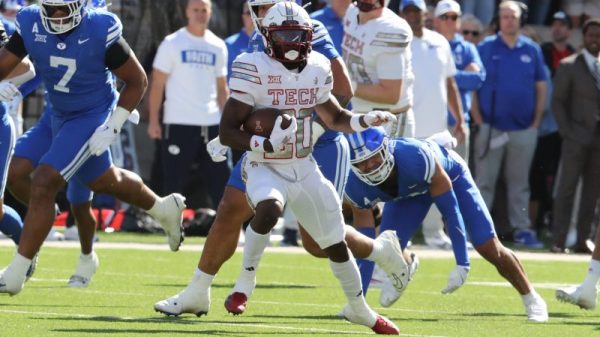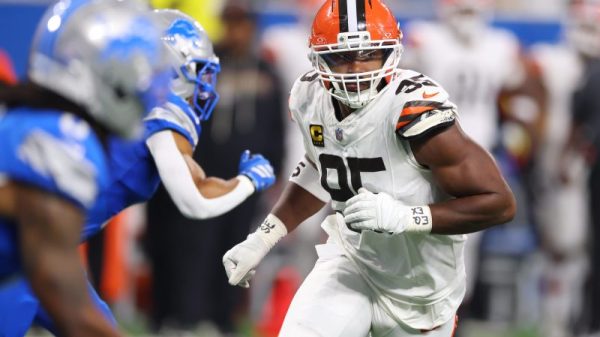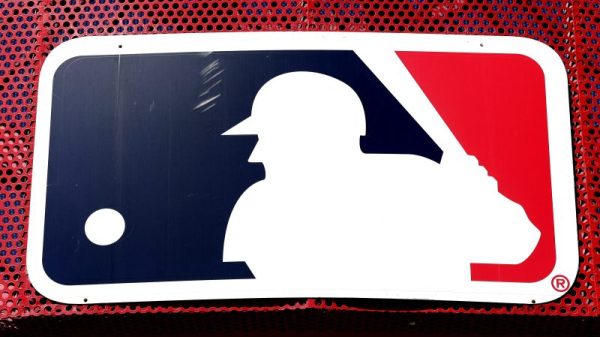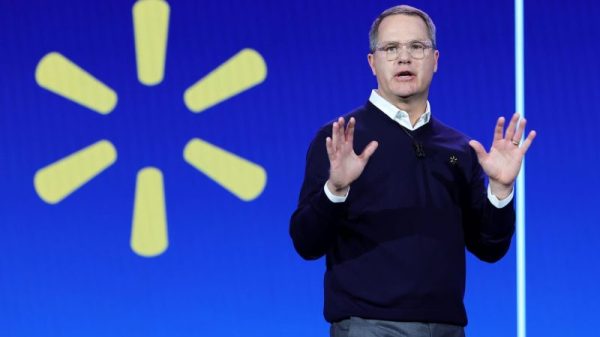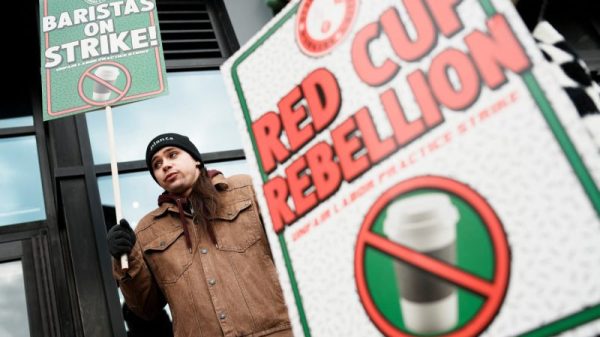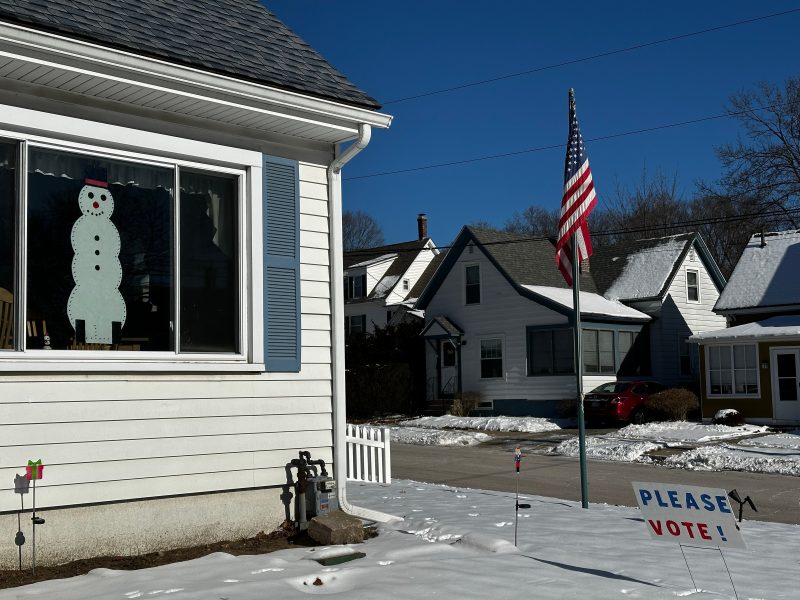MANCHESTER, N.H. — There were already two large trucks settled into a bank parking lot by 9 a.m. Saturday morning, 10 hours before Donald Trump was scheduled to speak at the arena across the street. The trucks were festooned with flags sharing the various slogans that Trump’s political efforts have accrued over the years: “Make America great again,” “Trump won,” FJB, that sort of thing.
The trucks were well-stocked with Trump gear, which must have been disappointing to the various vendors setting up nearby. A coterie of people was unloading vans and erecting tables to hawk hats, shirts, signs, bumper stickers and flags aimed at tapping into the microeconomy that springs up around Trump events like hippie capitalists outside a Grateful Dead show. But that disappointment would have been softened by simply looking across the street where a few dozen people were already lined up to enter that evening’s event.
It was 11 degrees according to a nearby sign, and no one standing outside for more than 30 seconds would have doubted it. That included the guy on the sidewalk in front of the arena, waving first a “TRUMP WON” sign and then “TRUMP 2024.” It included, too, the people already rifling through the vendors’ ubiquitously red Trump-stamped scarves and hats.
Get-out-the-vote weekend had begun.
This, also abbreviated as GOTV weekend, is the term of art for the Saturday and Sunday before an Election Day, two days on which campaigns can expect that more people will be home — and therefore reachable by phone or at their doors — and that more people will be free to volunteer to engage in those activities. These efforts are generally called “field,” the direct-voter outreach that research shows can have a significant effect on influencing voters to support a candidate or, by GOTV weekend, convince them to go vote.
Since 2016, I’ve gone to New Hampshire on the weekend before the primary to evaluate which campaigns were more successfully reaching out as voting loomed. In that first cycle, for example, Sen. Bernie Sanders’s (I-Vt.) organization and volunteer support stood out, as it did four years later. But during each visit, professional operations were fielding and dispatching volunteers (at varying scale, certainly) and volunteers — and the vestiges of their efforts — could be seen while exploring Manchester neighborhoods: people walking between doors or the door-hangers with polling-place information they were leaving on doorknobs.
This year, that was not the case.
There was a campaign effort in Manchester that reeked of professionalism and experience, one that was polished and bore the hallmarks of people who knew what they were doing. It was, as you probably predicted, that of Rep. Dean Phillips (D-Minn.), long-shot challenger to President Biden.
That is a joke, of course, given the low familiarity Phillips has with Democrats around the country. But his campaign headquarters along Elm Street, downtown Manchester’s central thoroughfare, looked the way a Hollywood set designer might outfit such a facility: street-level space in a handsome bank building, walls covered with posters and Phillips (or, as the campaign’s marketing team seems to prefer, “Dean”) gear — including jerseys bearing his name — and lots of young people bustling around with laptops and coffee.
Just … not that many volunteers. When I came in on Saturday morning, two staffers told me that they were preparing for an event that day. (The communications staffer they’d suggested I email first told me that the campaign was going to be sending out volunteers to walk but later said that they weren’t.) I did meet one young volunteer making calls; she’d volunteered for Phillips’s congressional office over the summer.
Events like the one that Phillips ultimately held on Saturday are not generally considered particularly useful for turning people out on Election Day. Targeted voter contact lets you try to influence specific voters — like people who only vote about half the time but would vote for your candidate — allowing you to add votes to your total in small increments. That’s the goal: not to turn an imminent loss into a landslide but, instead, to give a slight edge of a few percentage points in a close contest. A big event, by contrast, is meant to generally get people excited about the candidate, including people who might come in from out of state or people who won’t end up voting.
The big event in Manchester this weekend was Trump’s Saturday rally at the Southern New Hampshire University Arena, a pure visibility/energizing push. It was disruptive, with a massive police presence that shut down a chunk of the downtown area for most of the day. But Trump’s campaign also had smaller events at its headquarters located a half-block from police headquarters, a facility much more modest than Phillips’s — but far more crowded.
I arrived there on Saturday morning shortly after House Conference Chair Elise Stefanik (R-N.Y.) had finished speaking. Walked in the door toward the back of the one-story building and was immediately unable to make much forward progress. It was cold, remember, and no one seemed eager to leave the narrow hallway where a harried staffer attempted to direct people. I was directed into a smaller inner room where another staffer was training people to make phone calls over the din of conversations from the still-packed main space, the most prominent feature of which was a floor-to-ceiling painting of Donald Trump’s Truth Social avatar: a stern-looking Trump with an American flag superimposed on his face.
But the campaign was doing what campaigns should do on the weekend before an election: lure people in and get them to make calls. It’s not clear how many of the callers had been enticed by Stefanik’s visit or were simply regulars (the harried greeter at one point recognized a person he referred to as their “top greeter”) but the point remains: People were encouraged during the event to do voter contact and some actually were.
Many of those working there were from out of state, given the license plates in the parking lot and the constant mentions of nearby Massachusetts. There were young guys in suits and ties and at least one older woman in a fur jacket. When I first came in, I overheard a conversation about the frustrations of having to have a percentage of housing reserved for low-income tenants.
This diverged from the crowd lining up for the speech, which leaned much more heavily toward the working-class, heavily bearded end of the spectrum. Outside the headquarters were SUVs and sedans; the parking lots starting to fill up near the arena had more pickup trucks focused.
My approach to evaluating how each campaign was conducting its voter outreach the weekend before the election was to simulate being a willing volunteer, figuring out where campaigns were accepting people and then showing up. Of the seven campaigns that existed at the start of the weekend, only Phillips and Trump had obvious operations welcoming volunteers. I found Democrat Marianne Williamson’s headquarters, on an upper floor of a building around the corner from Trump’s, and was advised by a volunteer to come back after 10 a.m. At 10, the door was locked. I saw a sign for the longest of long-shots, Ryan Binkley, that asked people “Who is Ryan Binkley?” without providing a URL for his campaign, which about sums up his campaign.
The other major Republican candidates, though, were surprisingly hard to track down. I submitted a volunteer request through Ron DeSantis’s campaign website and through the site for the super PAC supporting his campaign that had coordinated much of the operational work; I never heard back from either for reasons that now seem obvious — the campaign would cease to exist soon after the inquiry.
My submission through Nikki Haley’s site garnered a response — a generic one, ignoring what I’d said I wanted to do and instead focused more heavily on contributing money. Unlike DeSantis (who spent part of the weekend campaigning in South Carolina before presumably catching a flight to Florida), I knew Haley was holding events in some smaller towns near Manchester. I drove to one, hoping to learn more from the campaign staff or hear the closing-hours pitch from the candidate.
The former U.N. ambassador was holding an afternoon event in the town hall of Peterborough, N.H., a remarkably picturesque town about an hour west of Manchester. There were a few Haley signs lining the sidewalk; the room where she spoke had about 100 in the audience with television cameras behind them. It was all well-engineered, one element of the churning machine that is running a presidential campaign. But it was an unrewarding journey — a Haley staffer (again harried) pointed me back to Manchester and sent my information to his higher-ups.
There was no obvious effort to shift those attending events into volunteers, as was done by Trump’s team. At her earlier event in Keene, N.H., Haley had appealed to the audience to engage by bringing 10 of their friends to the polls; this, it seems, was her GOTV appeal. It’s an appeal that is about as passive as you can get; a room of 100 people bringing 10 friends gives you at most 1,000 more votes. Who would? If you had to, could you find 10 friends or family members who didn’t support your candidate and get them to come out and vote?
Marcia Trudeau, 80 (or maybe 82, she said), is an example of why one might view Haley’s exhortation skeptically. A Democrat, she lives in Manchester with her husband and (Republican) daughter, Anne. The lawn outside their house had a small handmade sign that read “PLEASE VOTE.”
Marcia and Anne were at the door when I knocked on Sunday morning. I was spending some time in (similarly cold) weather knocking on the doors of regular primary voters to determine how much they’d heard from candidates. At many doors, no one answered. At some, I received a curt “not interested,” which is not uncommon.
The Trudeaus answered. At one point during our discussion (with Anne in the background), Marcia said she was frustrated that she would “never convince” her family to vote the way she wanted to.
Anne, who declined to give her age, offered frustration at the campaigning. Her family, she said, had heard from “all of them.”
“It’s, like, obnoxious, all the fliers — everything. It’s just too much,” Anne added. The outreach was more than in past years, she said, though with fewer people knocking on their door.
Michael Hickey, 52, lived nearby. A Republican, he agreed that there seemed to be more outreach — calls, mailings and fliers being left at doors — than in recent years.
“The mailings certainly are up,” he said. “The phone calls have increased, not exponentially but definitely increased.” There hadn’t been anyone at his door recently; the undisturbed-until-I-arrived snow on his steps reinforced that.
Hickey said he planned to vote for Haley but said he was “kind of half-in, half-out when it comes to politics.” I asked if the election seemed more or less important than ones in the past and he offered a bit of a shrug.
“I would say the same,” he said. “I don’t get too excited about negative news.”
There are two ways to consider the lack of campaigning in New Hampshire on the weekend before the primary.
One way is to wonder whether New Hampshire — or other — primary fights simply don’t work the way they used to. Trump is sui generis and perhaps non-replicable; something suggested by DeSantis’s efforts to run a similarly too-good-for-my-challengers campaign. But perhaps door-knocking and phone-calling don’t land the way they used to and one can simply win in New Hampshire without them.
The other way is to admit that the Republican primary was over before it began. Trump’s wide national lead trickles down into the state, and there was never much reason to think that he would be derailed any more than he had been at any other point over the past eight years. DeSantis saw the writing on the wall and withdrew on Sunday.
It’s very possible that Haley did, too. We’ll see if she outperforms expectations on Tuesday, though the lack of outreach on GOTV weekend doesn’t suggest that she’ll squeak by Trump by the percentage points that a good field operation can add.
While I was talking to voters on Sunday, the Trump campaign was again welcoming a big-name surrogate to its headquarters, Rep. Matt Gaetz (R-Fla.). Trump was headed upstate for another big rally that night in Rochester, N.H. Donald Trump Jr. was scheduled to visit on Monday. Trump’s heavy footprint in the state is a reminder of his resources and (particularly compared with his odd presence in 2016) his political experience. He is the establishment candidate, carrying high-profile endorsements around in his pocket like so many nickels and dimes.
Maybe that’s the explanation: Well before New Hampshire began readying for its primary, the 2024 race was simply a battle between two incumbents.
Marianne LeVine contributed to this report.






